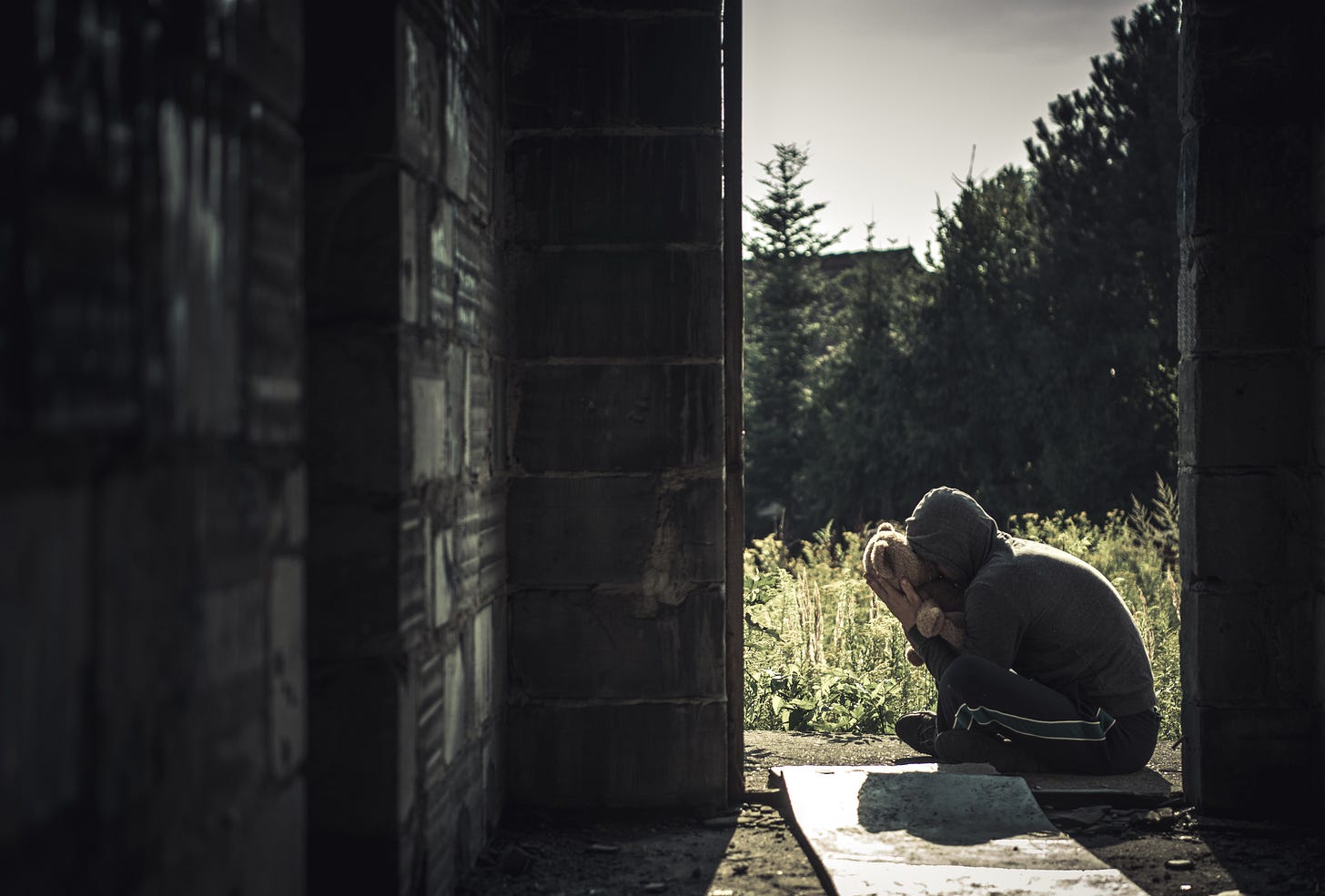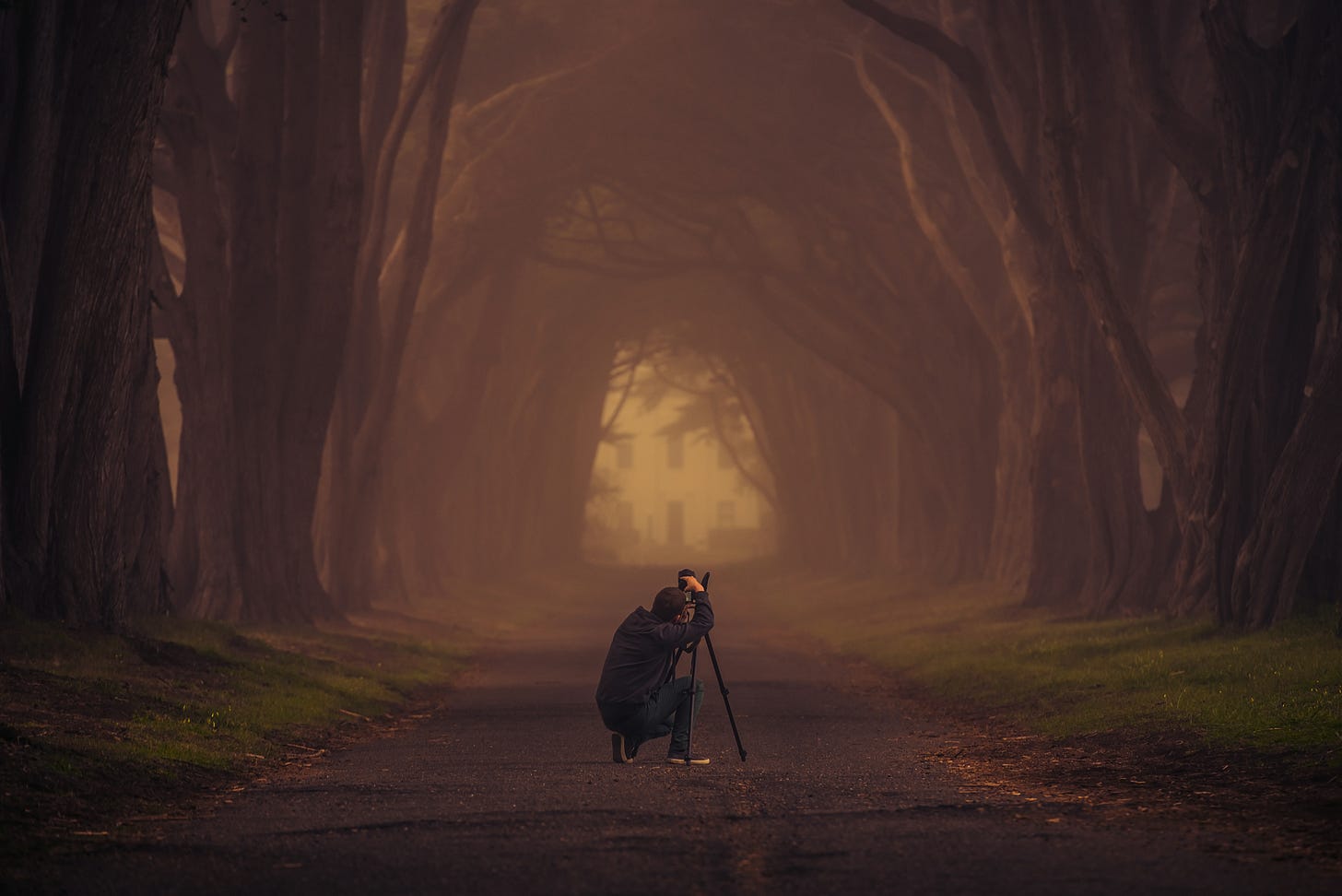The Spiritual Homelessness Epidemic:
How Sacred Dissonance Is Creating a Generation of Wanderers
There's a story playing out in churches, synagogues, mosques, and spiritual communities across the world. It's not the story religious leaders want to tell, but it's the one millions of people are living. It's the story of spiritual homelessness—and it's creating one of the most significant cultural shifts of our time.
The Story We're Not Telling
Sarah sits in the back pew of the church where she grew up, where she was baptized, confirmed, and married. She knows every hymn, every prayer, every rhythm of the liturgy. But today, like every Sunday for the past two years, she feels like a stranger in what was once home.
Meanwhile, across town, Marcus hasn't set foot in a church building in five years. Not since the pastor told him his questions about science and faith meant he was "letting the world corrupt his mind." Not since he realized that asking hard questions made people uncomfortable, and uncomfortable people made him unwelcome.
Three blocks away, Ana sits in her car in the parking lot of the mosque where her family still worships. She knows if she goes inside, she'll hear whispered conversations about her marriage breakdown, sideways glances at her uncovered hair, subtle reminders that she's no longer the person they once embraced. She loves Allah. She finds peace in prayer. But she doesn't love feeling like a disappointment to her community.
Sarah, Marcus, and Ana share something profound: they still believe in the divine. They still hunger for community and meaning and transcendence. But the containers that once held their faith—whether through evolution or exclusion—no longer feel like home.
They don't have a category for what they're feeling. They only know that they're spiritually homeless—and they're part of a massive, largely invisible community.
Across denominations, traditions, and continents, millions of people are experiencing what researchers are calling the "spiritual homelessness epidemic." Some, like Sarah, have outgrown their spiritual containers while remaining physically present. Others, like Marcus and Ana, have been pushed out by judgment, rejection, or the simple inability to fit into spaces that once claimed to welcome all.
They haven't lost their faith; they've either evolved beyond their spiritual containers or discovered those containers were never truly big enough for who they are. They're not abandoning God; they're searching for authentic ways to connect with the divine that honor both their spiritual heritage and their full humanity.
This isn't a story about people leaving religion. It's a story about people whose spiritual growth—or whose authentic selves—created a sacred tension, a dissonance, between where they've been and where their souls are being called to go. It's about the millions who've been told they don't belong, and the millions who've realized they can no longer pretend to fit where they don't.
The Character We've Misunderstood
In every compelling story, there's a character everyone misunderstands. In the spiritual homelessness epidemic, that character is Sacred Dissonance.
Most religious communities treat Sacred Dissonance as the villain—the troublemaker that disrupts peace, challenges authority, and threatens stability. When someone experiences that uncomfortable tension between inherited beliefs and emerging spiritual truth, the typical response is to fix it, suppress it, or counsel it away.
But what if we've gotten the story wrong?
What if Sacred Dissonance isn't the villain but the herald—the character who announces that transformation is coming, that growth is trying to happen, that something larger wants to be born?
Sacred Dissonance is the spiritual tension that emerges when your soul outgrows its container—or when you discover you were never truly welcomed in the container you thought was home. It's the uncomfortable space between the faith you inherited and the faith you're discovering. It's the gap between who you were spiritually taught to be and who you actually are. It's the ache of being told you don't belong in the place that taught you about belonging to God.
This tension isn't a bug in the spiritual system—it's a feature. It's how growth happens. It's how authentic faith develops. It's how people move from borrowed beliefs to personal conviction. It's also how people move from spaces of conditional acceptance to communities of genuine belonging.
The Plot Twist: Homelessness as Pilgrimage
Here's where the story takes an unexpected turn. What looks like spiritual homelessness might actually be spiritual pilgrimage.
Throughout history, every profound spiritual journey has involved leaving the familiar to discover the authentic. Abraham left his homeland. Moses left Egypt. Jesus left Nazareth. The disciples left their nets. The mystics left their comfort zones.
Spiritual homelessness often isn't evidence of lost faith—it's evidence of faith that's finally strong enough to seek its true home, or of humans who've finally found the courage to stop hiding who they really are.
Consider the patterns:
The Evolutionary Path (Sarah's Journey):
You begin with inherited spiritual identity (the hometown)
You encounter experiences that don't fit your inherited frameworks (the disruption)
You feel displaced, questioning, uncertain (the wilderness)
You discover new spiritual capacities and understanding (the awakening)
You find or create authentic spiritual expression (the true home)
The Exclusion Path (Marcus and Ana's Journey):
You begin believing you belong in your spiritual community (the assumed home)
You encounter rejection, judgment, or conditional acceptance (the expulsion)
You feel wounded, angry, and abandoned by both community and God (the exile)
You slowly separate your relationship with the divine from your relationship with the institution (the distinction)
You discover or create spiritual expression that welcomes your full self (the homecoming)
Neither path is easy. Both are sacred. Both lead to the same destination: authentic spiritual expression that doesn't require you to hide, shrink, or pretend.
This isn't a modern phenomenon. It's the archetypal journey of spiritual maturation that's been happening for millennia. The only difference is that now it's happening to millions of people simultaneously.
The Three Characters in Every Spiritual Homelessness Story
1. The Inherited Identity (Who You Were Taught to Be)
This is the spiritual self that was shaped by family, tradition, and community expectations. It includes:
Beliefs you accepted because they were handed down
Practices you followed because they were expected
Community belonging based on conformity and performance
Identity derived from external validation and approval
This character isn't evil—it's just incomplete. Like childhood clothes that no longer fit, inherited spiritual identity served its purpose, but often can't contain the full person you are or are becoming. Sometimes it was never designed to fit the real you at all.
2. The Sacred Dissonance (The Tension That Drives Growth)
This is the uncomfortable space between inherited identity and emerging authenticity. It manifests as:
Questions that won't go away despite pressure to stop asking
Spiritual experiences that don't fit traditional categories
Hunger for depth that surface expressions can't satisfy
Tension between belonging and authenticity
The pain of being told you don't belong because of who you are
The exhaustion of hiding parts of yourself to maintain acceptance
The grief of losing community when you stop pretending
Sacred Dissonance isn't the enemy—it's the catalyst. It's the character that refuses to let you settle for spiritual mediocrity or conditional acceptance, that keeps pushing you toward your authentic spiritual expression, where you can be fully known and fully loved.
3. The Awakened Identity (Who You're Becoming)
This is the spiritual self that emerges through engaging Sacred Dissonance rather than avoiding it. It includes:
Beliefs you've personally tested and chosen
Practices that genuinely connect you with the divine
Community based on mutual growth and unconditional acceptance rather than mutual agreement
Identity rooted in divine calling rather than human approval
The freedom to be fully yourself in spiritual space
The peace of knowing you belong to God regardless of institutional acceptance
The joy of community that celebrates rather than merely tolerates your authentic self
This character represents your spiritual destiny—but it can only emerge by moving through, not around, Sacred Dissonance.
The Hero's Journey of Spiritual Homelessness
Every compelling story follows a predictable pattern, and spiritual homelessness is no exception. Understanding this pattern can transform the experience from crisis to adventure.
Act 1: The Comfortable Life
You're settled in your spiritual community. You know the rules, speak the language, and have a clear identity. But something begins stirring—a question, an experience, a longing that doesn't fit your current spiritual framework.
Act 2: The Call to Adventure
Sacred Dissonance arrives as a call to spiritual adventure. It whispers that there's more to discover, deeper truths to explore, and authentic expression to claim. This call can be exciting, but it's also terrifying because it requires leaving the familiar.
Act 3: Refusing the Call
Most people initially resist Sacred Dissonance. You try to squeeze new spiritual experiences into old categories. You work harder at practices that no longer connect. You seek comfort in a community that feels increasingly constraining.
Act 4: Crossing the Threshold
Eventually, the dissonance becomes impossible to ignore. You acknowledge that your spiritual journey requires leaving familiar territory. This feels like homelessness, but it's actually the beginning of finding your true spiritual home.
Act 5: The Wilderness
This is the most difficult part of the journey. You feel spiritually displaced, questioning everything, unsure of your identity. Traditional communities may reject you for asking questions or being yourself. Progressive communities may not understand your continued spiritual hunger. You feel like you belong nowhere. For those who've been excluded, this wilderness includes deep wounds of rejection and the struggle to separate God's love from institutional judgment.
Act 6: Allies and Guides
In the wilderness, you discover others on similar journeys. You find guides who've navigated Sacred Dissonance before you. You meet people who've been rejected for the same reasons you have, or who've asked the same questions that got you labeled as "difficult." You realize you're not alone, not broken, and that your experience is part of a larger pattern of spiritual evolution and divine invitation.
Act 7: The Ordeal
You face your deepest fears about spiritual authenticity. What if you're wrong? What if you lose community? What if you disappoint those who shaped your original faith? What if you never find belonging again? What if God really does judge you the way people did? What if your authentic self really is incompatible with divine love? This is where many people turn back—but those who continue discover something unexpected.
Act 8: The Reward
Through engaging Sacred Dissonance rather than avoiding it, you discover spiritual gifts you didn't know you possessed. Authentic prayer. Genuine compassion. Real wisdom. True calling. You discover that God's love is actually larger than institutional approval, that your authentic self is celebrated rather than tolerated by the divine, that the very things that made you unwelcome in religious spaces might be the gifts the world needs most. These weren't available in your comfortable spiritual life because they only emerge through transformation.
Act 9: The Return
You don't return to your original spiritual community unchanged—if you return at all. Many find that true homecoming means creating new forms of spiritual community. You bring wisdom, authenticity, and gifts that can serve others, making the same journey. You become a safe space for others experiencing Sacred Dissonance, whether through evolution or exclusion. You help create the kind of spiritual home you wish had existed when you needed it most.
The Cultural Moment We're Missing
Here's what most religious leaders don't understand: the spiritual homelessness epidemic isn't a crisis to solve—it's a movement to serve.
We're living through the largest spiritual awakening in human history. More people are experiencing Sacred Dissonance simultaneously than ever before. This isn't because faith is failing—it's because consciousness is expanding faster than spiritual containers can adapt.
The question isn't how to stop spiritual homelessness—it's how to guide it toward authentic spiritual homes.
Instead of treating Sacred Dissonance as a problem to fix, what if we recognized it as:
Evidence of spiritual maturation rather than spiritual crisis
Invitation to authentic faith rather than a threat to traditional faith
Catalyst for community innovation rather than the cause of community division
Pathway to calling rather than an obstacle to belonging
The Story's Resolution
Every great story needs a satisfying resolution, and the spiritual homelessness epidemic has one—but it requires rewriting the ending we've been expecting.
The resolution isn't getting everyone back to traditional religious practice. That story is over for millions of people, and trying to force it only creates more homelessness.
The resolution isn't abandoning the spiritual community altogether. Isolation isn't the answer to institutional dysfunction.
The resolution is creating new forms of spiritual community that can hold both tradition and transformation, inheritance and innovation, belonging and becoming.
This means:
Communities that welcome questions instead of fearing them
Leaders who guide spiritual development instead of managing spiritual compliance
Practices that connect people to the divine instead of maintaining institutional control
Identity rooted in divine calling instead of human approval
Displaced individuals, thirsty and hungry people, questioners, and other "outcasts" are celebrated rather than tolerated
Environments where neurodiversity, cultural differences, and unconventional spiritual expressions are seen as gifts rather than problems
Community where belonging isn't conditional on performance, agreement, or hiding parts of yourself
Your Role in This Story
If you're reading this and recognizing your own experience of spiritual homelessness—whether you've outgrown your container or been pushed out of it—you're not broken. You're not faithless. You're not alone. You're not too much, too little, too different, or too difficult.
You're a character in one of the most significant spiritual stories of our time.
Your Sacred Dissonance isn't a mistake—it's a message. It's telling you that your soul is ready for its next chapter, that authentic spiritual expression wants to emerge through you, that you have gifts waiting to be discovered. If you've been excluded or rejected, your exclusion might be pointing you toward the spiritual community you're meant to help create.
The spiritual homelessness you're experiencing might be the pathway to the spiritual home you're meant to find—or build—not just for yourself, but for others making the same journey.
To those who've been told they don't belong: The God who created you in infinite diversity is not surprised by who you are. Your authentic self is not a mistake to be fixed but a gift to be celebrated. The rejection you've experienced says more about institutional limitations than divine love.
To those who've outgrown their spiritual containers: Your questions and growth are not betrayals of faith but expressions of a faith mature enough to seek truth beyond comfortable boundaries. Your spiritual evolution is not apostasy—it's awakening.
The Next Chapter
The spiritual homelessness epidemic is really a spiritual awakening in disguise. Sacred Dissonance is really a sacred invitation wearing the mask of spiritual crisis.
The question isn't whether you'll experience Sacred Dissonance—it's how you'll respond when you do.
Will you treat it as a problem to solve or a mystery to explore? Will you seek to return to comfort or journey toward authenticity? Will you allow it to drive you into isolation or guide you toward community? Will you let rejection define your worth, or will you trust that your authentic self has a place in God's vast love? Will you shrink to fit into spaces too small for your soul, or will you find the courage to seek—or create—spaces large enough for who you really are?
The story of spiritual homelessness only becomes tragic when we refuse to see it as the beginning of a larger adventure toward authentic belonging.
Your Sacred Dissonance is trying to tell you something. Your spiritual restlessness is pointing you somewhere. Your sense of homelessness—whether from outgrowing your container or being excluded from it—might be the first step toward finding or creating your true spiritual home.
To those who've been pushed out: Your exclusion is not God's rejection. Your difference is not a defect. Your authentic self has infinite worth and a sacred place in the divine story.
To those who've evolved beyond: Your questions are not threats to faith but expressions of faith mature enough to grow. Your spiritual expansion is not betrayal but becoming.
The question is: Are you ready for that adventure?
Are you ready to stop apologizing for who you are? Are you ready to stop shrinking to fit into spaces too small for your soul? Are you ready to discover that spiritual homelessness might be the pathway to spiritual homecoming?
What has been your experience with spiritual homelessness? Have you felt caught between inherited faith and emerging authenticity? Have you been excluded for being your authentic self? Have you found spaces where you can be fully known and fully loved? Share your story in the comments below—you might discover you're part of a larger journey than you realized, and your story might be exactly what someone else needs to hear.
Ready to explore your own Sacred Dissonance journey? Take the Sacred Dissonance Assessment to discover which of the 12 spiritual journey types most closely matches your experience of spiritual homelessness and transformation.
For spiritual leaders: If you're serving people experiencing Sacred Dissonance—whether through evolution or exclusion—learn how to create truly welcoming spaces through our Sacred Sanctuary facilitator training.
For the spiritually homeless: You belong. Your questions belong. Your authentic self belongs. The journey home begins when you stop trying to fit into spaces too small for your soul and start seeking—or creating—the spiritual community you were meant to find. You’re not alone, and I am offering you a home.







This is a great model to help people going through these changes to understand what is happening to them.
Sacred Dissonance is not a problem to fix. It is an invitation to authentic faith rather than a threat to traditional faith.
Thank you so much for this, Master Coach A! It helps me to understand the emotions and the discomfort of feeling excluded. Now, there’s a term for it.